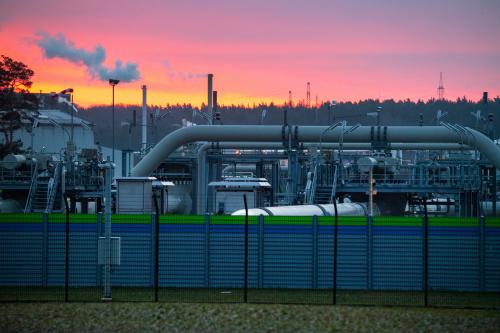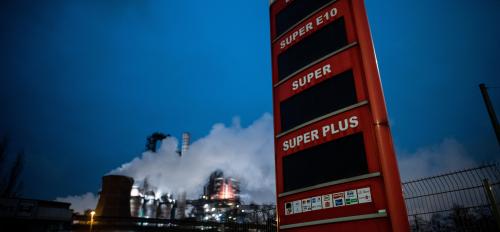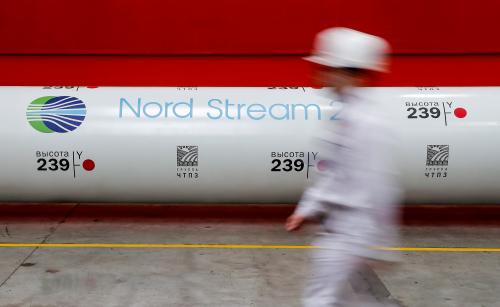Americans have no idea how good we have it with respect to energy prices. Although we are suffering through the worst inflation since 1982, with higher energy prices as a component, we still enjoy much lower energy prices than our friends in Europe. American natural gas (as liquified natural gas, or LNG) is flowing toward Europe in response to their very high prices — a good business deal for U.S. companies, a counterweight to Russia’s power over European energy supply, and a gesture of good will toward our staunchest allies. Although several members of Congress are calling for limiting U.S. natural gas exports in response to inflation at home, it is a terrible idea, harmful to U.S. foreign policy and useless in lowering prices for American consumers.
Europeans are suffering through a supply crunch in natural gas, translating into extremely high prices. At its high point late in 2021, the European wholesale natural gas price was more than six times its level at the same time in the previous year. Prices have fallen a bit since then, but are still six and a half times their level in the United States. For average Europeans, this translates into very high prices for home heating and electricity and even shutdowns in some industries that rely on gas.
Curtailment in Russian gas supply is an important part of the European supply crunch. In addition to the massive military buildup on Ukraine’s border, Russia is weaponizing its natural gas supply to Europe. Pipelines carrying Russian gas generally supply around 35% of Europe’s natural gas; today that share is only 17%. Since the fall of 2021, Russia has met its contractual obligations to supply gas to Europe, but nothing more, amounting to a halving of its usual supply. Gazprom also did not fill its European storage facilities to their usual level in advance of the winter, especially in Germany, which lacks the specialized port facilities that are needed to receive LNG imports as an alternative. Combine these Russian shortfalls with decreasing production from Europe’s own gas fields, lower inventories owing to a cold spring, and lower-than-usual production of wind power, and you have a recipe for a severe supply crunch.
Increased LNG imports have been making up some of the difference. In January 2022, European LNG imports to were nearly triple their level from one year ago. U.S. LNG exports are a crucial part of stabilizing Europe’s gas market. According to Andrew Light of the U.S. Department of Energy, as of last week, 60 cargoes of U.S. LNG had reached Europe in 2022 or were on the way, making up about half of the extra LNG supplied to Europe during this difficult time. U.S. LNG producers have been going all-out in response to high European prices and the United States became the world’s largest LNG exporter in January.
Nonetheless, in a letter dated February 3, 11 U.S. senators pushed Energy Secretary Jennifer Granholm to “take swift action to limit U.S. natural gas exports” to lessen the impact of rising prices on American consumers. This suggestion is not only mean-spirited, but also potentially undermines U.S. foreign policy.
The ability to bring replacement gas into Europe lessens the impact of Russian President Vladimir Putin’s natural gas weapon. For this reason, we’ve seen U.S. President Joe Biden work to find LNG for Europe beyond what the United States can supply, meeting with Qatari Emir Sheikh Tamim bin Hamad Al Thani and convincing Japan to divert some LNG to Europe. Reducing demand for gas by curtailing production of gas-intensive products during cold snaps could also help Europe get through this difficult winter. However, over the longer run Europe clearly needs to move away from its reliance on Russian pipeline gas to reduce Moscow’s leverage. The transition toward renewable sources of electricity is a big step in the right direction.
In addition to undermining U.S. foreign policy, cutting back on LNG exports is unlikely to make much difference in prices at home. The United States consistently enjoys some of the world’s lowest natural gas prices. U.S. LNG export capacity is expanding, but the United States has huge natural gas reserves and production is likely to expand along with export capacity. The world will eventually move away from natural gas as it transitions to a zero-carbon energy system, but the United States is likely to enjoy its price advantage in natural gas for the foreseeable future, even with expanding exports.
The request to limit gas exports is a political response to crushing inflation in an election year. But there is plenty of gas to go around in the United States, and supply is recovering after a dip during the pandemic. The Biden administration is making the right call to focus on the larger issues at hand — keeping Europe warm and opposing Russian aggression. One of the advantages of energy supplies from the United States on the world market is that they are much less subject to political manipulation than those from state-owned companies; instead individual companies are making their own business decisions. Despite the pain of today’s inflation, now is not the time to change.






Commentary
Now is not the time to limit U.S. natural gas exports
February 18, 2022